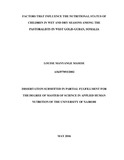| dc.description.abstract | The nutritional situation of Somalia’s pastoral population remains vulnerable, the key causes of malnutrition are limited nutrient intake and high disease prevalence. This study set out to determine the key factors that influence the nutritional status of children aged 6-59 months, within the West Golis-Guban pastoral livelihood in a dry and wet season. Cross sectional nutrition surveys were conducted in the wet and dry season of October 2008 and July 2009, collecting information on anthropometry, food consumption, child feeding and morbidity. A total of 535 and 772 children were assessed in the dry and wet season respectively. Data was mainly collected using a standard household forms. Data was analysed using ENA and SPSS software packages. Chi Square tests was used to test significance and associations, logistic regression was used for testing the relationship between categorical variables and relevant independent variables, P value for statistical significance was set at <0.05. The prevalence of global acute malnutrition during the dry season was 22.3%, with 6.6% being severely malnourished. These rates were significantly lower (p=0.006), in the wet season (13.3% and 2.5% respectively), indicating lower levels of acute malnutrition in the wet season. The common foods consumed in both season was cereals, sugar and oils, dietary diversity as better in the wet season with vegetables, milk and pulses consumed in addition to the common foods. A higher proportion of households (86.5%) consumed a diverse diet (≥ 4 food groups) during the wet season compared to the dry season (76.4%). A significantly higher (p= 0.000) proportion of households consumed milk during the wet season (60.4%) compared to the dry season (33.5%). Regression analysis showed a positive relationship between household dietary diversity score and weight for height z scores in the wet season. There was no difference in the proportion of children aged 6-24 months breastfeeding in the wet (49.1%)
xvi
and dry season (48.9%). Only 13.5% and 12.7% of children in the dry and wet seasons respectively were consuming five or more meals a day, child feeding practices did not vary between seasons. Morbidity was reported at 37.4% in the dry season and 16.2% in the wet season, children had been ill, mainly with diarrhoea, ARI in the dry season, and malaria in the wet season. There was a statistically significant (p=0.001) difference in the proportion of children who fell ill in the dry and wet seasons. There was also an association between morbidity and acute malnutrition, with children being 1.72 and 3.95 times more likely to be malnourished in the dry and wet season respectively. The study concludes that nutritional status of children is poorer in the dry season. The main foods consumed are cereals, sugar and oil in both seasons. Dietary diversity is better in the in the wet season as it also includes vegetables, pulses and milk. Morbidity especially diarrhoea, ARI and malaria are the main diseases that affect children in both seasons. Malaria is higher in the wet season. Therefore interventions that ensure access to dietary diversity at all times, such as ensuring adequate feeds and water to livestock all year round to enable pastoralists to have adequate milk supply or income through sales of animal products to purchase nutritious foods especially milk should be implemented. In addition, programmes that reduce diseases among the children in both seasons is important, for example increasing access to consumption of safe water, immunization and malaria control are important. Interventions designed to improve child feeding practices (breastfeeding and complementary feeding) should also be implemented. | en_US |



